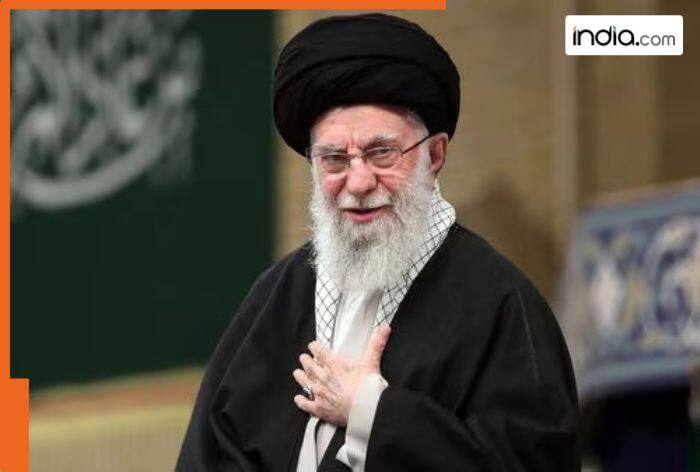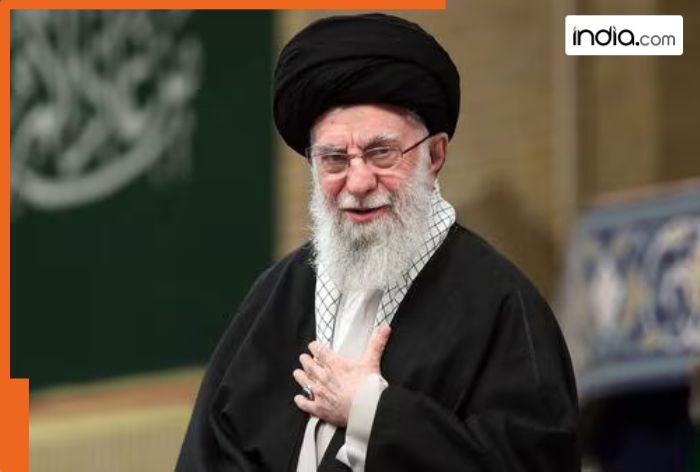The exact size depends on the design and the specific technology being used, but they are generally designed to maximize efficiency while maintaining structural integrity under high-speed rotation.

ALTHOUGH IRAN DOES NOT currently have nuclear weapons, analysts think its nuclear programme could become a key target for Israeli retaliation—despite US objections—following Iran’s missile attacks on Israel. On Tuesday (October 1), Iran launched more than 180 missiles at Israel without warning, in retaliation to an attack that killed topmost Hezbollah leader Hassan Nasrallah. This has led to widespread speculation about how Israel will respond.
Iran’s attack lays the groundwork for a counterstrike by Israel, which could be the “decisive action” that Prime Minister Netanyahu has hinted at—potentially focusing on Iran’s nuclear or oil facilities—according to Laura Blumenfeld, a Middle East analyst from Johns Hopkins University quoted by Forbes.
Although Israel’s exact target is still unknown, an Israeli official said the country planned to respond swiftly, according to a report by NBC citing an unnamed source. On Wednesday, President Joe Biden informed reporters that the US would not back any Israeli strikes on Iran’s nuclear facilities.
Mohammed al-Basha, a Middle East security analyst, told Forbes that speculation was rife that Israel could target Iran’s Bushehr power plant. Bushehr is Iran’s only working nuclear power plant and runs on Russian fuel, which has a low risk of being used for weapons. He compared this to how Israel had responded to Houthi attacks by bombing fuel depots as a show of strength.
Throughout 2024, US intelligence has consistently reported that Iran has not developed nuclear weapons. However, since 2018, Iran has significantly expanded its nuclear programme by building hundreds of additional centrifuges. This escalation began after the US, under President Donald Trump, withdrew from a nuclear agreement with Iran. According to The Wall Street Journal (WSJ), these centrifuges are crucial for enriching uranium, a key step in nuclear development.
In April, senior Iranian general Ahmad Haghtalab warned that Iran might reconsider its nuclear policies if Israel attacked its nuclear sites. He stated that such an attack could lead to Iranian counterattacks on Israel’s own nuclear facilities, according to a report from the state-run Islamic Republic News Agency.
BACKGROUND TO N-ARMS PROGRAMME
Since Iran began its nuclear weapons programme in the late-1990s and early-2000s, Israel, along with the US and the UN, has been concerned about its progress. Over the years, Israel has taken steps to disrupt Iran’s nuclear development, including such secret operations as sabotage, cyber attacks and even stealing nuclear secrets, in an effort to stop Iran from advancing its nuclear capabilities. Although Israel never admitted it, Iran accused them of being behind the assassination of its top scientist, Mohsen Fakhrizadeh, in 2020.
Iran has accumulated enough highly enriched nuclear fuel to create three bombs. It is also one of the few countries without nuclear weapons that can produce uranium enriched to 60%, which is near the 90% level needed for making nuclear weapons, according to WSJ. In recent years, Russia’s relationship with Iran has grown stronger, raising concerns in the US. According to Bloomberg, the US is worried about the possibility of Russia sharing technology and information with Iran, which could boost Iran’s nuclear ambitions.
Israel is thought to have nuclear weapons, but it has never officially confirmed this. This makes it an undeclared nuclear power, according to the Center for Arms Control and Non-Proliferation.
WHY ENRICHING URANIUM IS NECESSARY
Natural uranium is found in many places around the world but, in its raw form, it cannot be used to make nuclear weapons. It is also not useful in most nuclear reactors for producing electricity or creating plutonium. The uranium must first be processed and enriched to make it suitable for these purposes. Plutonium is created for both military purposes, such as building weapons, and for energy production in specific types of reactors.
Natural uranium is made up of different types, called isotopes. Most of it, around 99.3%, is uranium-238, while only a small part, about 0.7%, is uranium-235. Uranium-235 is special because it is ‘fissile’—meaning it can be split or broken apart easily when hit by slow-moving neutrons, releasing energy in the process—which makes it useful in nuclear reactions.
An isotope refers to different forms of the same chemical element. While all isotopes of an element have the same number of protons, they have different numbers of neutrons in their nuclei. This difference in neutron count does not change their chemical properties much, but it can affect their stability and how they behave in nuclear reactions. For instance, uranium-238 and uranium-235 are isotopes of uranium, with different numbers of neutrons.
Uranium-235 is the most important type of uranium for use in reactor fuel and making nuclear weapons because it can easily undergo fission. However, in its natural form, there is not enough uranium-235. To make it useful for these purposes, the amount of uranium-235 needs to be increased by separating it from uranium-238. This process is called enrichment.
ENRICHMENT LEVEL THAT REACTORS NEED
Uranium with enrichment levels higher than 0.7% but below 20% uranium-235 is classified as low-enriched uranium (LEU). Most nuclear reactors used for civil and commercial purposes operate with LEU that typically contains 3-5% uranium-235. Examples of LEU used for civil and commercial purposes include generating electricity in power plants, conducting research in nuclear reactors and producing medical isotopes used in diagnostic imaging and cancer treatments.
Uranium enriched to over 20% uranium-235 is called highly enriched uranium (HEU). While all HEU can be used to make weapons, lower enrichment levels require a larger quantity of uranium to reach the critical mass needed to create a bomb. Countries with nuclear weapons usually use what is called weapons-grade HEU, which is enriched to 90% or more. This higher enrichment allows for smaller and lighter nuclear weapons, making them easier to transport. In particular, ballistic missiles can only carry nuclear weapons that have been miniaturized.
Uranium has a density similar to gold and takes up much less space for its weight compared to a metal such as iron (gold: 19.32 g/cm³, iron: 7.87 g/cm³).
THE PROCESS FOR ENRICHING URANIUM
Before uranium can be enriched, it must be mined from the ground and milled, followed by chemical processing. Natural uranium ore is extracted from Earth’s crust. While uranium is found in many places worldwide, five countries—Australia, Kazakhstan, Russia, Canada and Niger (in West Africa)—hold 65% of the known uranium ore reserves.
After uranium ore is mined, it is crushed to separate the uranium from the rock around it. This process, called milling, results in producing uranium oxide concentrate (U3O8)—commonly known as yellowcake. This yellowcake is sent to a conversion facility where impurities are removed and the uranium is mixed with fluorine to create uranium hexafluoride (UF6), a gas that can be used for enrichment.
Since uranium-235 and uranium-238 are chemically the same, common chemical methods for purification cannot be used to separate them. Enrichment methods take advantage of the small difference in mass—about 1%—between the heavier, more common uranium-238 isotope and the lighter, fissile uranium-235 isotope.
Various methods have been used to enrich uranium. During the Manhattan Project, the US used electromagnetic isotope separation (EMIS), but it was very energy-intensive and was abandoned after the war due to its inefficiency and high cost. During the Cold War, gaseous diffusion became the main method for enrichment but this, too, required a lot of electricity and large facilities. Laser excitation, a newer technology, has not yet proven to be commercially viable.
THE GAS CENTRIFUGES PROCESS
Today, the most common and efficient method for enriching uranium is the use of gas centrifuges. In this process, uranium hexafluoride (UF6) gas is spun at high speeds in a series of cylindrical centrifuges. The centrifugal force causes the heavier uranium-238 isotopes to move towards the outer edge, while the lighter uranium-235 isotopes remain closer to the centre.
This allows for the gradual separation of uranium-235 from uranium-238. Gas centrifuges are highly efficient and require much less electricity compared to such older methods as gaseous diffusion, making them the preferred technology for uranium enrichment today. The speed of gas centrifuges used for uranium enrichment typically ranges from around 18,000 to 90,000 revolutions per minute (rpm). These high speeds create the necessary centrifugal force to separate the uranium-235 from uranium-238.
The size of gas centrifuges used for uranium enrichment can vary, but most are tall, narrow cylinders. They typically range in heights of about 3 metres to 12 metres (10 feet to 40 feet) and have a diameter of about 15 centimetres to 20 centimetres (6 inches to 8 inches). The exact size depends on the design and the specific technology being used, but they are generally designed to maximize efficiency while maintaining structural integrity under high-speed rotation.
THE RISK OF N-ARMS PROLIFERATION
Uranium enrichment is a nuclear proliferation risk because the same technology that produces low-enriched uranium (LEU) for reactor fuel can also be used to create highly enriched uranium (HEU) for nuclear weapons. There are no technical limitations stopping countries with enrichment technology from using it to produce weapons-grade uranium—only legal restrictions are in place to prevent it.
Centrifuges create a special challenge for preventing nuclear proliferation because it is hard to detect hidden facilities in time and existing centrifuges can be quickly adjusted to produce highly enriched uranium (HEU). At present, countries known to have uranium enrichment capabilities include France, the UK, the Netherlands, Germany, the US, Russia, Argentina, Brazil, India, Pakistan and Iran.
(The author of this article is a Defence, Aerospace & Political Analyst based in Bengaluru. He is also the Director of ADD Engineering Components, India, Pvt. Ltd, a subsidiary of ADD Engineering GmbH, Germany. You can reach him at: girishlinganna@gmail.com)
(DISCLAIMER: The views and opinions expressed in this article are those of the author and do not necessarily reflect the official policy or position of India.com. The writer is solely responsible for any claims arising out of the contents of this article.)

